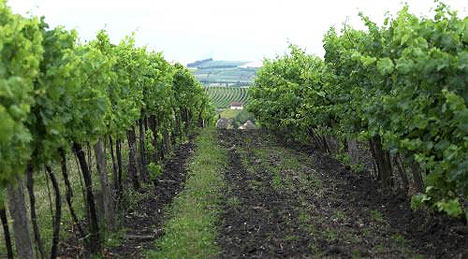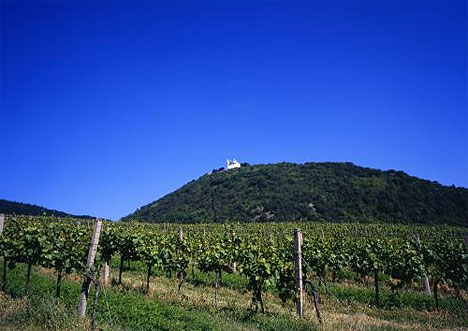Weinviertel
The Weinviertel is by far the largest wine-growing region in Austria. It covers a total of around 17,000 hectares of vineyards and thus almost one third of the total area planted with vines in Austria. The Weinviertel is not necessarily a homogenous area. It is bordered in the southwest by the wine-growing regions of Kamptal and Wagram and in the south by the Danube. It extends in the north along the Czech border and in the east along the Slovakian border around Vienna and ends again shortly before the Carnuntum wine-growing region on the Danube. The vineyards are widely scattered throughout the area and have distinctly different soil types. The climate is predominantly continental, but a Pannonian influence is already noticeable in the very east. In addition, there is a small climatic island near Haugsdorf and Mailberg, which is considered particularly well suited for the cultivation of red varieties due to its very warm and dry conditions.
 |
| Weinviertel% vineyard (Source: Österreich Wein Marketing GmbH) |
Considering the highly diverse conditions in the Weinviertel, it is surprising that the DAC, introduced in 2002, was the first wine-growing region to create a designation of origin for a wine with a clearly defined taste. Today, this project can certainly be called a model of success. Although the DAC applies exclusively to Grüner Veltliner, the name of the variety is often no longer found on the label. Most producers succeed surprisingly well in bringing the desired peppery-fruity and rather crisp taste to the bottle. However, it is noticeable that some producers have recently left their wines with a little more residual sugar than necessary, and the notorious "144er" or "Mössmer" clone, which produces wines with aromas quite clearly reminiscent of Scheurebe or Sauvignon, has not yet completely disappeared from the scene. What is new is the introduction of a "Reserve" category, which now also offers a home to more powerful versions with more than 13% alcohol and even those with a noticeable wood influence.
Around half of the vineyard area in the Weinviertel is planted with Veltliner, but other varieties are also repeatedly producing remarkable wines here. After Veltliner, the most important varieties in terms of volume are Welschriesling and Müller-Thurgau, but the better results, depending on the location, are usually achieved by Burgundy varieties and Riesling, although Welschriesling can also be quite impressive. The area under Sauvignon and Muskateller is increasing, while that of the traditional mixed grape variety is clearly decreasing. However, the area under red wine is increasing even more strongly, which is mainly due to Zweigelt, whose area has increased enormously in recent years to almost 1,700 hectares - and has now eclipsed that of the previously dominant Blauer Portugieser.
Vienna
Vienna is the only capital city in the world with a significant wine-growing area. At the moment, the vineyard area amounts to almost 700 hectares - and is still growing. Compared to the Weinviertel region, the amount of all wine produced in Vienna is barely more than a drop, but the drop is quite something. Although one might assume that Vienna, with its Heurigen culture, has no sales problems for its wine, and producers are therefore not necessarily forced to place particular emphasis on superior quality, the quality of many wines is impressive.
 |
| Nussberg (Source: Österreich Wein Marketing GmbH) |
The best Veltliners and Rieslings have a noblesse that is not inferior to wines from the best Wachau or Kamptal sites. The Gemischter Satz also has a very lively tradition here. Basically the Heurigen wine par excellence, in the hands of the most committed producers it also rises to become a top wine region. Especially the wines from Vienna's most famous vineyard, the Nussberg, rightly enjoy an excellent reputation. As in the Weinviertel, the share of red varieties is steadily increasing in Vienna - and here, as there, there are some producers who go about producing top-class red wines with great ambition.
Weinviertel DAC in the wine guide
All producers from the Weinviertel
Viennese white wines in the Wine Guide